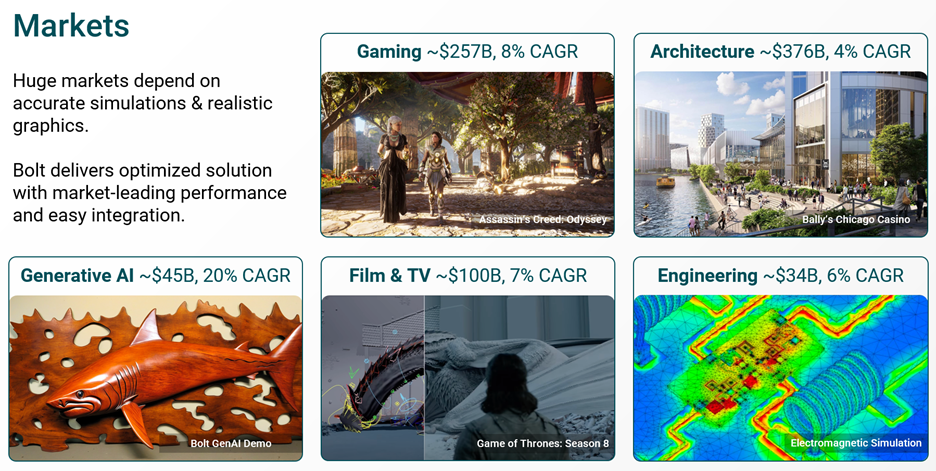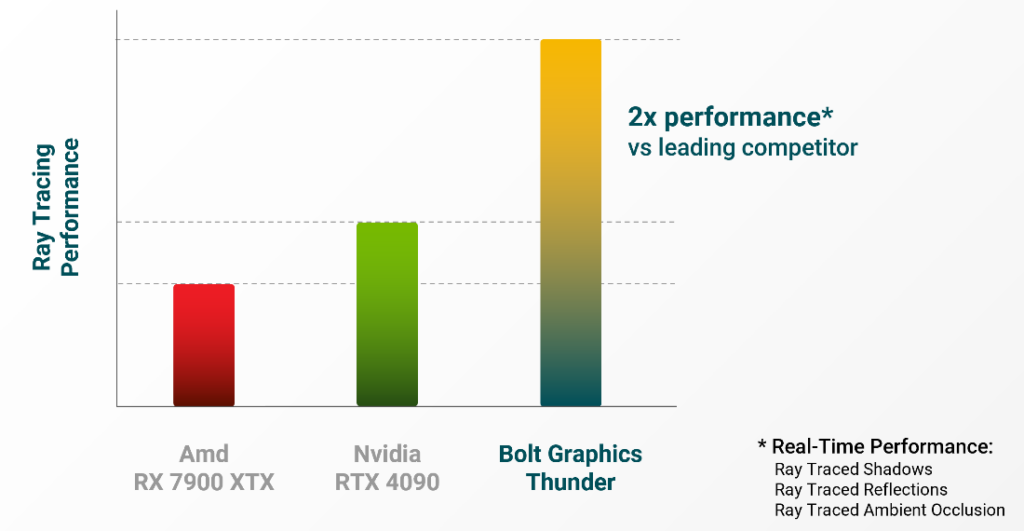What do we think? Bolt Graphics was founded in 2020 based on some clever ideas about how to accelerate ray tracing with a special hardware architecture. Since then, the company raised capital, found some customers, and has been simulating and developing its design. The moment of truth is approaching, and it plans to show the world how ray tracing should be done, and without any help or tricks from AI. This could be an inflection point in ray tracing, or it could be another corner case as so many breakthroughs before it have been.
Who is Bolt Graphics and what is it developing?
Bolt says its technology closes the performance gap and enables users to create complex 3D graphics and simulations (for games, films, and digital twins) without resorting to the work-arounds and optimizations needed today. The company has developed a suite of silicon IPs to enable customers to make the efficient and high-performance SoCs.

Bolt says its mobile ray-tracing IP, Lightning, is optimized for low-power smartphone, tablet, and laptop processors, and is currently being integrated inside a GPU partner’s IP.
Bolt’s cloud ray-tracing IP, Thunder, says the company, is heavily optimized for modern rendering workloads. According to Bolt’s founder, Darwesh Singh, Thunder is already being implemented into advanced-node chiplets, which he says are faster than the best GPUs today, while consuming less energy so it has lower cooling requirements. When looking at a data center full of chiplets, that could drastically reduce cost through lower power consumption. Those chiplets, says the company, will be available for use in major clouds and inside prebuilt servers towards the end of 2024.

Bolt says it has a pipeline of four highly interested potential licensees looking at mobile, automotive, and data center use cases.
- Bolt is a member of the Open Compute Project (OCP) Foundation and says its customer chiplets will be deployed using OCP specs—the company is using the OAM form factor (similar to Nvidia SXM and Intel Habana boards).
- Bolt also is working with OCP to develop their next-gen form factor, called HPCM, with a bunch of other silicon/system vendors.
- The company’s focus is on increasing performance and reducing power consumption—so its end solutions do not require exotic liquid cooling solutions, although they are more efficient.
- Customers can elect to use various combinations of DDR/CXL for memory and PCIe/UCIe/Ethernet for system connectivity.
Bolt points out that chiplets are smaller than typical smartphone SoCs and they are not necessarily GPUs or CPUs. A SiP can contain one, two, or four chiplets.
The chiplets are in emulation today and, says the company, are being integrated directly into major software packages, using the company’s SDK and with the help of vendors such as Autodesk (Maya, 3ds Max, Revit, AutoCAD, Inventor Pro, Fusion 360), Epic (Unreal Engine), Unity, Blender, and Foundry (Nuke, Katana, Modo).
Software integration was made easier, says Bolt, by building its SDK to support key shared technologies:
- USD: File exchange format that works across all major content creation tools.
- MaterialX: Material definition that works across many major content creation tools.
- Hydra: Renderer interface that works across all the tools listed above, except for Unreal and Unity, which are in development.
For Unreal and Unity, the company started with a plug-in, and its next step is to build directly into Unreal’s RHI and Unity’s URP/HDRP.
- Its SDK is built from the ground up to support them.
- Remote or shared memory (through CXL pooling and CXL over Ethernet) is provided.
Lightning and Thunder are fully developed, says the company, and are on the market today. Bolt launched those IPs at CES 2023 and will be at CES 2024 showing demos of the technologies in emulation.
Lightning and Thunder are the same core architecture, just scaled down for mobile (Lightning) or scaled up for data center (Thunder). This is a very different direction/approach from the company’s GPU competitors. Bolt says it also does a lot of things differently in the ray-tracing steps, but at the end, the resulting rendered frame is similar to production renderers. But, claims the company, its driver and SDK are 100× smaller than those of its competitors, so it’s much simpler for developers and users.